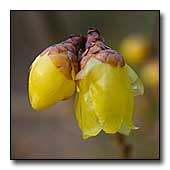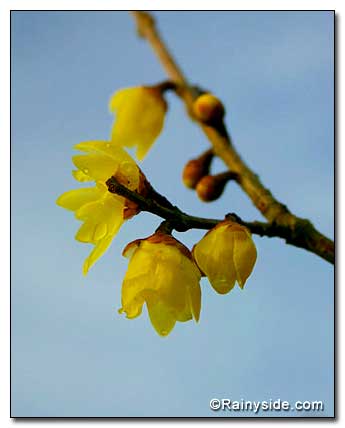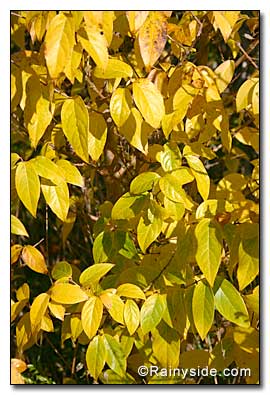Chimonanthus praecox var. luteus
WINTERSWEET
syn. 'Concolor', Chimonanthus praecox 'Luteus'
Family: Calycanthaceae
Pronounced: KY-mo-nan-thus PREE-koks

Quick Jumps
Growing Guide
Rainy Side Notes
GROWING GUIDE

Origin:
Garden.
Plant Group:
Shrubs.
Hardiness:
Sunset zones: 4-9, 14-24.
USDA: zones 7-9.
Mature size:
Height: 12 feet (4 m).
Width: 10 feet (3 m).
Flowering period:
Mid January to early February.
Flowering attributes:
Pendant, clear yellow flowers with a spicy fragrance.
Leaf attributes:
Glossy, lance-shaped, green leaves.
Growth habit:
Large shrub or prune as a small tree.
Light:
Full sun to light shade.
Soil:
Fertile, well-drained soil.
Feeding:
Side dress with compost and a complete organic fertilizer in spring.
Propagation Methods:
Soft wood cuttings in summer.
Pruning Methods:
This shrub needs little to no pruning. Prune immediately after flowering in late winter to take out crossed branches or to thin out weak stems. If pruned for a shrub, cut to within 6-12 inches of the ground if the shrub gets too leggy. To train as a tree, prune out side branches to make single or multi-stemmed trunks.
Pests and Diseases:
Not common for this shrub.
Rainy Side Notes

Chimonanthus praecox var. luteus churns out the most delectable fragrance and a little color to the winter garden. What else but yellow flowers to brighten a cloudy day in January? If you want more plants in bloom during the dead of winter, this large shrub (or small tree) is a must! The flowers of this variety are brighter yellow than the species.
Plant against a dark backdrop such as an evergreen to bring out the yellow flowers; if possible, have them backlit by the sun. If the sun decides to shine on a rare January day and the shrub is in bloom, it is memorable. Mine is planted along my driveway so that I can appreciate the flowers and fragrance as I pass it on my way to the mailbox. In fall, the leaves turn a soft lemon color.
Since Chimonanthus does little else the rest of the year, it would be a good choice to plant deciduous Clematis next to it. The vine can climb into the shrub and add another season of flowers to its otherwise uninteresting form. Choose a six to eight-foot tall vine with your favorite color flower that blooms in summer. Make sure the shrub has reached a good size before swamping it with a vine. Your neighbors will think you are growing some exotic shrub when the Clematis is in bloom.
This tall shrub throws me into a religious experience whenever I stand close enough to capture its essence. If you don’t have it in your garden, it’s time to discover this delectable bush, and place it in the ground near your front door. When the flower bursts into full bloom, take a deep breath, and then swoon over its sweetness. For lifting the heart, it’s better than consuming chocolate!
Photographed in author's garden.

Gardening for the Homebrewer: Grow and Process Plants for Making Beer, Wine, Gruit, Cider, Perry, and More
By co-authors Debbie Teashon (Rainy Side Gardeners) and Wendy Tweton

